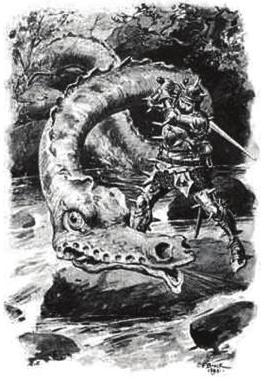How to Slay a Dragon, Realistically

One of the draws of Heroic Fantasy is that it takes the archetypal, the magical — the magical realistic even! — and makes it immersively real by engaging with it in a practical, sweaty-browed, grimy handed way.
For example, a surrealist artist might paint a city inhabited by human wolves, but James Enge in Wolf Age plunges his hero into a realistically imagined civilization of werewolves and makes him fight to survive physically and morally.
That’s what the genre does. It says: Assume this crazy but cool thing was true; what would be the implications?
Now, dragons are about as crazy and cool and magical as beasts get. Suppose you had to kill one?
Don’t look to Greek Myth for tips! Yes, Heracles prunes the Hydra to death, but he’s a demigod. Jason slays the Colchian dragon, but only after Media cast Sleep on it. Faced by a dragon, a mythological hero uses supernatural cheat codes. Puny humans without magic or divine descent don’t get a look in — which is fine. The listener, or reader, is civilised, and dragons belong to another era.
You’ll have more luck with the tales crafted — evolved in the telling — for the descendants of the barbarians who took down the Roman Empire. These rough men were accustomed to resolving problems through the medium of muscle-powered violence. The dragon, like a post-Roman city, a Byzantine army, or the walls of Jerusalem, merely presented an interesting challenge and thus their response becomes interesting to us:
So how does a Dark Age warrior or Medieval knight imagine he might kill a dragon?

(picture by Rami Tarawneh WikiMedia Commons)
St George and the Dragon: St George deploys the Sign of the Cross to ward off his dragon so he can then smite it. This is not quite a cheat because his sanctity is a personal quality rather than gift or accident of birth. Categorise this as Mojo.
Siegfried (aka “Sigurd”) and Fafnir: The Volsunga Saga is 13th century, but Siegfried’s death gets a mention in the 8th-century Beowulf, itself referring to earlier times, making Siegfried our earliest Germanic dragonslayer. Though he’s tooled up with Gram — basically a Sword of Smiting — Siegfried takes out the dragon Fafnir ninja-style by waiting in a trench and stabbing it in the belly. Ambush.
Beowulf and the Worm: Taking on his fire-breathing worm, the aging King Beowulf (the best retelling of Beowulf is still the Rosemary Sutcliff one, by the way) brings a big iron shield plus his entire warband. When the dragon goes all Apocolypse Now, the warband sensibly routs. However, while the well-mailed king keeps the monster busy by letting it try to eat him, a young warrior stabs it. This enables Beowulf to get his sword arm free and do the mighty deed. File this under teamwork and tech.
Vikings versus Dragons: There’s this 12th-century saga — Yngvar’s Saga — that’s basically nuts. A boatload of Vikings rampage up a Russian river tangling with a Metric Harryhausen of mythological monsters. Soon enough they come across a massive dragon. A recon establishes that the dragon takes a daily lumber to the river to drink. Fortunately, the Vikings have onboard — so help me Odin! — a salted giant’s leg (don’t ask!). They plant this delicacy in the dragon’s path. The dragon eats the salt meat, gets thirsty, and drinks so much water it imbolises itself. At this point the Vikings bring out their axes and use them not on the dragon, but on the dragon’s hoard which, realistically, is a big puddle of melted gold. They hack of a chunk and flee without actually killing the dragon.
I’m not sure how to categorise this one! Recon, poison and avoidance, I think.
Tristran and the Irish Dragon: Gottfried von Strassburg (around AD1200) describes how Sir Tristran takes out a troublesome firebreather by waiting in ambush in some bushes and charging out at the last moment. The dragon BBQs his horse, Tristran shish-kabobs the dragon’s mouth with his lance. Recon and ambush.

(NB: Please don’t hold your sword like this – MHP)
John Lambton and the Worm: In Northern English folklore — I think the technology used indicates a later medieval origin — young tearaway John Lambton goes up against a python-like worm using the most impressive of all the technological dragon-slaying aids: spiked armour. The dragon gets the lad in its coils and in doing so simply stabs itself to death. Tech.
All this should tell us that Medievals weren’t stupid like in Palin’s Jabberwocky. The real definition of chivalry focused on winning (and thus proving God was on your side) by almost any means necessary short of obvious murder. For example, here’s one of our earliest fencing manuals — Codex Dobringer from around AD 1389 — on how to fight six people:
This is not great courage, but great stupidity to try for four or six [opponents]… It is better to hide away in a bed than to display such great clumsiness. But …if you are careful, and if you behave chivalrously and you part well from them then you will defend well against all….
There is no hurt or disgrace to run away from four or six. And when you turn and start to run away from him, then throw your sword across and run as fast as you can. Then as one who thinks that he has caught up with you and has closed with you…then leap to the side of the road and if he is running quickly after you,
then he will be moving too fast to control himself and you can strike him down as you wish.(Trans. Lindholm with my edits for readability)
Based on this and the hero tales, we can imagine a Medieval dragon-slaying treatise might read thus:
How to Slay a Dragon.
Don’t. If you can, and if the dragon does not dwell in your own country, use some ruse to steal its gold then flee.
However, if you must fight a dragon do it thus:
Get a good weapon if you can. A magic or dwarf-forged sword is best.
Assemble a team of battle-hardened fighters.
Set your blacksmith to work. An iron shield works well against fire. Spiked armour is good against coils.
Scout with care. Prepare an ambush site, dig a pit if there is no cover.
If possible, immobilize the dragon using some ruse such as poison, spiked armour as mentioned, or –(sigh) — religious symbols.
Attack the dragon with all your men. Do so with great gusto.
If you live, be warned that men will covet your glory and wealth…
…because — by the way– slaying the dragon is usually the easy part. Dragonslayers rarely die in their beds.
M Harold Page (www.mharoldpage.com) is a Scottish-based writer and swordsman with several Historical Adventure franchise books in print. His creative writing handbook, Storyteller Tools is available on Amazon. He’s also counting down the days until Loncon 2014 🙂